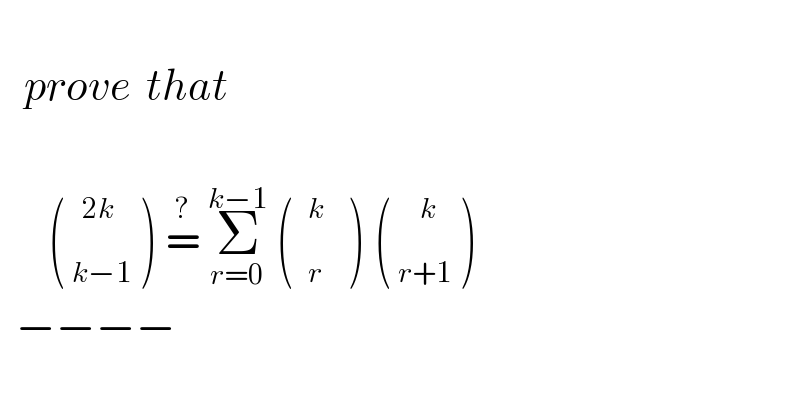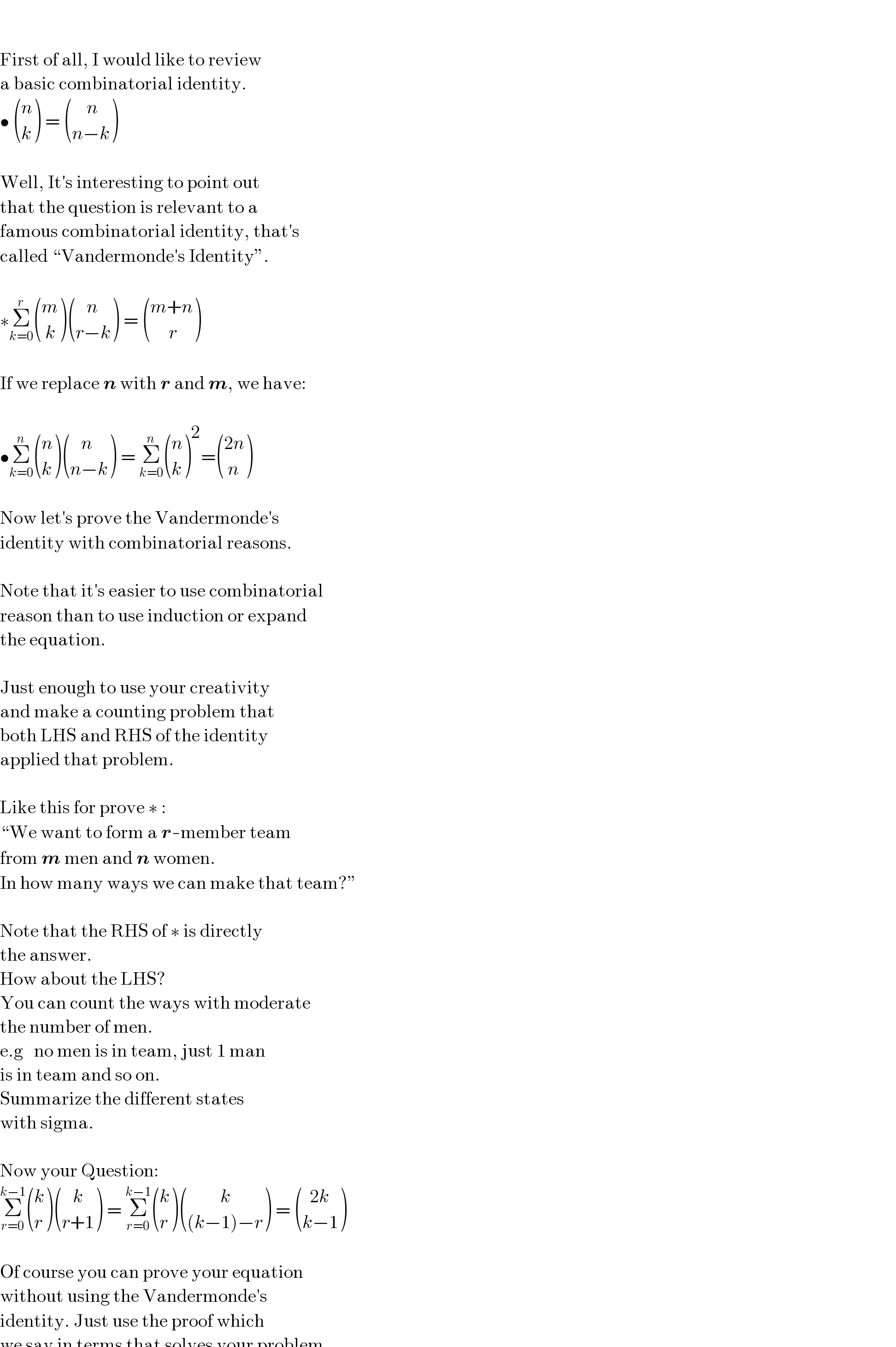
Question Number 164555 by mnjuly1970 last updated on 18/Jan/22

$$ \\ $$$$\:\:\:{prove}\:\:{that} \\ $$$$\: \\ $$$$\:\:\:\:\:\:\left(\underset{\:{k}−\mathrm{1}} {\overset{\mathrm{2}{k}} {\:}}\:\right)\:\overset{?} {=}\:\underset{{r}=\mathrm{0}} {\overset{{k}−\mathrm{1}} {\sum}}\:\left(\:\underset{\:{r}} {\overset{\:{k}} {\:}}\:\:\:\right)\:\overset{\:\:} {\left(}\underset{\:{r}+\mathrm{1}} {\overset{\:\:{k}} {\:}}\:\right) \\ $$$$\:\:−−−− \\ $$
Answered by mr W last updated on 19/Jan/22
![(1+x)^(2k) =(1+x)^k (1+x)^k Σ_(q=0) ^(2k) (((2k)),(q) )x^q =[Σ_(r=0) ^k ((k),(r) )x^r ][Σ_(p=0) ^k ((k),(p) )x^p ] let′s see term x^q with q=k−1 r+p=k−1 ⇒p=k−1−r≥0 ⇒r≤k−1 (((2k)),((k−1)) )=Σ_(r=0) ^(k−1) ((k),(r) ) ((k),((k−r−1)) ) (((2k)),((k−1)) )=Σ_(r=0) ^(k−1) ((k),(r) ) ((k),((r+1)) ) ✓](Q164563.png)
$$\left(\mathrm{1}+{x}\right)^{\mathrm{2}{k}} =\left(\mathrm{1}+{x}\right)^{{k}} \left(\mathrm{1}+{x}\right)^{{k}} \\ $$$$\underset{{q}=\mathrm{0}} {\overset{\mathrm{2}{k}} {\sum}}\begin{pmatrix}{\mathrm{2}{k}}\\{{q}}\end{pmatrix}{x}^{{q}} =\left[\underset{{r}=\mathrm{0}} {\overset{{k}} {\sum}}\begin{pmatrix}{{k}}\\{{r}}\end{pmatrix}{x}^{{r}} \right]\left[\underset{{p}=\mathrm{0}} {\overset{{k}} {\sum}}\begin{pmatrix}{{k}}\\{{p}}\end{pmatrix}{x}^{{p}} \right] \\ $$$${let}'{s}\:{see}\:{term}\:{x}^{{q}} \:{with}\:{q}={k}−\mathrm{1} \\ $$$${r}+{p}={k}−\mathrm{1} \\ $$$$\Rightarrow{p}={k}−\mathrm{1}−{r}\geqslant\mathrm{0}\:\Rightarrow{r}\leqslant{k}−\mathrm{1} \\ $$$$\begin{pmatrix}{\mathrm{2}{k}}\\{{k}−\mathrm{1}}\end{pmatrix}=\underset{{r}=\mathrm{0}} {\overset{{k}−\mathrm{1}} {\sum}}\begin{pmatrix}{{k}}\\{{r}}\end{pmatrix}\begin{pmatrix}{{k}}\\{{k}−{r}−\mathrm{1}}\end{pmatrix} \\ $$$$\begin{pmatrix}{\mathrm{2}{k}}\\{{k}−\mathrm{1}}\end{pmatrix}=\underset{{r}=\mathrm{0}} {\overset{{k}−\mathrm{1}} {\sum}}\begin{pmatrix}{{k}}\\{{r}}\end{pmatrix}\begin{pmatrix}{{k}}\\{{r}+\mathrm{1}}\end{pmatrix}\:\checkmark \\ $$
Commented by mnjuly1970 last updated on 19/Jan/22

$$\:\:\:{excellent}\:{sir}\:{W}\: \\ $$$$\:\:{grateful}... \\ $$
Answered by hmrsh last updated on 18/Jan/22

$$ \\ $$$$ \\ $$$$\mathrm{First}\:\mathrm{of}\:\mathrm{all},\:\mathrm{I}\:\mathrm{would}\:\mathrm{like}\:\mathrm{to}\:\mathrm{review} \\ $$$$\mathrm{a}\:\mathrm{basic}\:\mathrm{combinatorial}\:\mathrm{identity}. \\ $$$$\bullet\:\begin{pmatrix}{{n}}\\{{k}}\end{pmatrix}\:=\:\begin{pmatrix}{\:\:\:\:{n}}\\{{n}−{k}}\end{pmatrix} \\ $$$$ \\ $$$$\mathrm{Well},\:\mathrm{It}'\mathrm{s}\:\mathrm{interesting}\:\mathrm{to}\:\mathrm{point}\:\mathrm{out} \\ $$$$\mathrm{that}\:\mathrm{the}\:\mathrm{question}\:\mathrm{is}\:\mathrm{relevant}\:\mathrm{to}\:\mathrm{a}\: \\ $$$$\mathrm{famous}\:\mathrm{combinatorial}\:\mathrm{identity},\:\mathrm{that}'\mathrm{s} \\ $$$$\mathrm{called}\:``\mathrm{Vandermonde}'\mathrm{s}\:\mathrm{Identity}''. \\ $$$$ \\ $$$$\ast\underset{{k}=\mathrm{0}} {\overset{{r}} {\sum}}\begin{pmatrix}{{m}}\\{\:{k}}\end{pmatrix}\begin{pmatrix}{\:\:\:{n}}\\{{r}−{k}}\end{pmatrix}\:=\:\begin{pmatrix}{{m}+{n}}\\{\:\:\:\:\:{r}}\end{pmatrix} \\ $$$$ \\ $$$$\mathrm{If}\:\mathrm{we}\:\mathrm{replace}\:\boldsymbol{{n}}\:\mathrm{with}\:\boldsymbol{{r}}\:\mathrm{and}\:\boldsymbol{{m}},\:\mathrm{we}\:\mathrm{have}: \\ $$$$ \\ $$$$\bullet\underset{{k}=\mathrm{0}} {\overset{{n}} {\sum}}\begin{pmatrix}{{n}}\\{{k}}\end{pmatrix}\begin{pmatrix}{\:\:\:{n}}\\{{n}−{k}}\end{pmatrix}\:=\:\underset{{k}=\mathrm{0}} {\overset{{n}} {\sum}}\begin{pmatrix}{{n}}\\{{k}}\end{pmatrix}^{\mathrm{2}} =\begin{pmatrix}{\mathrm{2}{n}}\\{\:{n}}\end{pmatrix} \\ $$$$ \\ $$$$\mathrm{Now}\:\mathrm{let}'\mathrm{s}\:\mathrm{prove}\:\mathrm{the}\:\mathrm{Vandermonde}'\mathrm{s} \\ $$$$\mathrm{identity}\:\mathrm{with}\:\mathrm{combinatorial}\:\mathrm{reasons}. \\ $$$$ \\ $$$$\mathrm{Note}\:\mathrm{that}\:\mathrm{it}'\mathrm{s}\:\mathrm{easier}\:\mathrm{to}\:\mathrm{use}\:\mathrm{combinatorial} \\ $$$$\mathrm{reason}\:\mathrm{than}\:\mathrm{to}\:\mathrm{use}\:\mathrm{induction}\:\mathrm{or}\:\mathrm{expand} \\ $$$$\mathrm{the}\:\mathrm{equation}. \\ $$$$ \\ $$$$\mathrm{Just}\:\mathrm{enough}\:\mathrm{to}\:\mathrm{use}\:\mathrm{your}\:\mathrm{creativity} \\ $$$$\mathrm{and}\:\mathrm{make}\:\mathrm{a}\:\mathrm{counting}\:\mathrm{problem}\:\mathrm{that} \\ $$$$\mathrm{both}\:\mathrm{LHS}\:\mathrm{and}\:\mathrm{RHS}\:\mathrm{of}\:\mathrm{the}\:\mathrm{identity} \\ $$$$\mathrm{applied}\:\mathrm{that}\:\mathrm{problem}. \\ $$$$ \\ $$$$\mathrm{Like}\:\mathrm{this}\:\mathrm{for}\:\mathrm{prove}\:\ast\:: \\ $$$$``\mathrm{We}\:\mathrm{want}\:\mathrm{to}\:\mathrm{form}\:\mathrm{a}\:\boldsymbol{{r}}-\mathrm{member}\:\mathrm{team}\: \\ $$$$\mathrm{from}\:\boldsymbol{{m}}\:\mathrm{men}\:\mathrm{and}\:\boldsymbol{{n}}\:\mathrm{women}. \\ $$$$\mathrm{In}\:\mathrm{how}\:\mathrm{many}\:\mathrm{ways}\:\mathrm{we}\:\mathrm{can}\:\mathrm{make}\:\mathrm{that}\:\mathrm{team}?'' \\ $$$$ \\ $$$$\mathrm{Note}\:\mathrm{that}\:\mathrm{the}\:\mathrm{RHS}\:\mathrm{of}\:\ast\:\mathrm{is}\:\mathrm{directly} \\ $$$$\mathrm{the}\:\mathrm{answer}. \\ $$$$\mathrm{How}\:\mathrm{about}\:\mathrm{the}\:\mathrm{LHS}? \\ $$$$\mathrm{You}\:\mathrm{can}\:\mathrm{count}\:\mathrm{the}\:\mathrm{ways}\:\mathrm{with}\:\mathrm{moderate} \\ $$$$\mathrm{the}\:\mathrm{number}\:\mathrm{of}\:\mathrm{men}. \\ $$$$\mathrm{e}.\mathrm{g}\:\:\:\mathrm{no}\:\mathrm{men}\:\mathrm{is}\:\mathrm{in}\:\mathrm{team},\:\mathrm{just}\:\mathrm{1}\:\mathrm{man} \\ $$$$\mathrm{is}\:\mathrm{in}\:\mathrm{team}\:\mathrm{and}\:\mathrm{so}\:\mathrm{on}. \\ $$$$\mathrm{Summarize}\:\mathrm{the}\:\mathrm{different}\:\mathrm{states} \\ $$$$\mathrm{with}\:\mathrm{sigma}. \\ $$$$ \\ $$$$\mathrm{Now}\:\mathrm{your}\:\mathrm{Question}: \\ $$$$\underset{{r}=\mathrm{0}} {\overset{{k}−\mathrm{1}} {\sum}}\begin{pmatrix}{{k}}\\{{r}}\end{pmatrix}\begin{pmatrix}{\:\:\:{k}}\\{{r}+\mathrm{1}}\end{pmatrix}\:=\:\underset{{r}=\mathrm{0}} {\overset{{k}−\mathrm{1}} {\sum}}\begin{pmatrix}{{k}}\\{{r}}\end{pmatrix}\begin{pmatrix}{\:\:\:\:\:\:\:\:\:{k}}\\{\left({k}−\mathrm{1}\right)−{r}}\end{pmatrix}\:=\:\begin{pmatrix}{\:\:\mathrm{2}{k}}\\{{k}−\mathrm{1}}\end{pmatrix} \\ $$$$ \\ $$$$\mathrm{Of}\:\mathrm{course}\:\mathrm{you}\:\mathrm{can}\:\mathrm{prove}\:\mathrm{your}\:\mathrm{equation} \\ $$$$\mathrm{without}\:\mathrm{using}\:\mathrm{the}\:\mathrm{Vandermonde}'\mathrm{s} \\ $$$$\mathrm{identity}.\:\mathrm{Just}\:\mathrm{use}\:\mathrm{the}\:\mathrm{proof}\:\mathrm{which} \\ $$$$\mathrm{we}\:\mathrm{say}\:\mathrm{in}\:\mathrm{terms}\:\mathrm{that}\:\mathrm{solves}\:\mathrm{your}\:\mathrm{problem}. \\ $$
Commented by mnjuly1970 last updated on 19/Jan/22

$${thanks}\:{alot}\:{sir} \\ $$
Commented by Rasheed.Sindhi last updated on 19/Jan/22

$$\mathcal{W}{ith}\:{good}\:{explanation}! \\ $$
